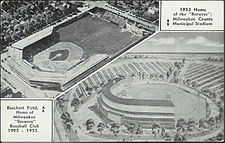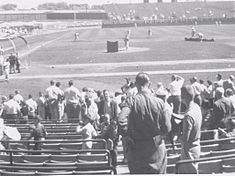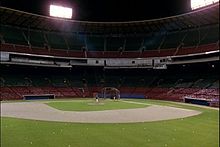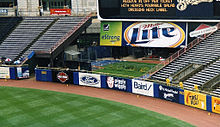- Milwaukee County Stadium
-
Milwaukee County Stadium County Stadium 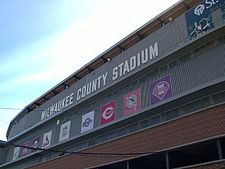
Location 201 South 46th Street
Milwaukee, Wisconsin 53208Coordinates 43°1′49″N 87°58′25″W / 43.03028°N 87.97361°WCoordinates: 43°1′49″N 87°58′25″W / 43.03028°N 87.97361°W Broke ground 1951 Opened April 6, 1953 Closed September 28, 2000 Demolished February 21, 2001 Owner Milwaukee County Surface Grass Construction cost US$5 million
($41.1 million in 2011 dollars[1])Architect Osborn Engineering General Contractor Hunzinger Construction[2] Capacity 36,011 (1953)
44,091 (1954–1955)
43,117 (1956)
43,768 (1957–1969)
45,768 (1970–1972)
46,000 (1973–1974)
47,500 (1975–1976)
52,293 (1977–1978)
54,187 (1979–1980)
53,192 (1981–2000)Field dimensions Left Field – 315 ft
Shallow L.C. – 362 ft
Deep L.C. – 392 ft
Center Field – 402 ft
Deep R.C. – 392 ft
Shallow R.C. – 362 ft
Right Field – 315 ft
Backstop – 60 ftTenants Milwaukee Braves (MLB) (1953–1965)
Green Bay Packers (NFL) (1953–1994, part time)
Chicago White Sox (MLB) (1968–1969, part-time)
Milwaukee Panthers (NCAA) (1968–1971)
Milwaukee Brewers (MLB) (1970–2000)Milwaukee County Stadium (or just County Stadium in context) was a ballpark in Milwaukee, Wisconsin from 1953 to 2000. It was primarily used as a baseball stadium for the Milwaukee Braves and Brewers, but was also used for football games, ice skating, religious services, concerts and other large events. It was replaced by Miller Park.
Contents
Construction
Milwaukee County Stadium was originally built as a home for the Milwaukee Brewers of the minor league American Association, replacing the outdated and deteriorating Borchert Field.
Several locations around the city were considered before the city settled on Story Quarry, on the west side of Milwaukee. County Stadium was the first ballpark in the United States financed with public funds.[3] Construction began in October 1950 and, hampered by steel shortages during the Korean War, was completed in 1953.
The city of Milwaukee also hoped to use the new facility to attract a Major League Baseball franchise (the city had been considered a potential relocation target for years), and in this respect their efforts were immediately successful. In fact, the minor league Brewers would never get a chance to play at the new stadium.
Major League Baseball
Milwaukee Braves (1953–1965)
Even before it was completed, the new "Milwaukee County Municipal Stadium" drew the interest of major league clubs. The St. Louis Browns, who had played in Milwaukee in 1901, the inaugural season of the American League, applied for permission to relocate back to the city they had left half a century before. The Boston Braves, the parent club of the Brewers, blocked the proposed move.[4] The Braves had long been struggling at the gate in Boston, and rumors of them relocating had been floating for some time. The move to keep Milwaukee available as a new home indicated to many observers that the Braves would move to Milwaukee themselves.
Three weeks before the beginning of the 1953 season, and right before the new stadium was ready to open, the Braves made it official, applying for permission to relocate. The other National League owners agreed, with the team becoming the Milwaukee Braves. The Braves' first home game, on April 6, 1953 was an exhibition contest against the Boston Red Sox. In their first season in Milwaukee, the Braves set the National League attendance record of 1.8 million. The first published issue of Sports Illustrated on August 16, 1954, featured County Stadium and batter Eddie Mathews on its cover.
On July 12, 1955, County Stadium hosted the 22nd All-Star Game. The National League won, 6–5, on a 12th inning home run by Stan Musial.[5] The Braves would also host back-to-back World Series in 1957 and 1958 against the New York Yankees. The Braves would defeat the Yankees in 1957 only for the Yankees to defeat them the next year.
The stadium continued to be the National League's top draw until 1959 when the Dodgers, who had moved to Los Angeles two years before, overtook the Braves (both in the stands and on the field). In the early 1960s attendance fell, along with the Braves' standings, amid an unstable ownership situation. The Milwaukee Braves used the stadium until 1966, when new owners, seeking a larger television market, moved the team to Atlanta.
Chicago White Sox (1968–1969)
In an effort to return Major League Baseball to Milwaukee after the departure of the Braves, local businessman and minority Braves owner Bud Selig brought other teams to play at County Stadium, beginning with a 1967 exhibition game between the Chicago White Sox and Minnesota Twins. The exhibition game attracted more than 51,000 spectators, so Selig's group contracted with Sox owner Arthur Allyn to host nine Chicago White Sox home games at County Stadium in 1968.
Selig's experiment was staggeringly successful – those nine games drew 264,297 fans. Those games took place on May 15 vs. the California Angels,[6] May 28 vs. the Baltimore Orioles,[7] June 17 vs. the Cleveland Indians,[8] June 24 vs. the Minnesota Twins,[9] July 11 vs. the New York Yankees,[10] July 22 vs. the Oakland A's,[11] August 2 vs. Washington Senators,[12] August 8 vs. the Boston Red Sox,[13] and August 26 vs. the Detroit Tigers.[14] In Chicago that season, the Sox drew 539,478 fans to their remaining 58 home games. In just a handful of games, the Milwaukee crowds accounted for nearly one-third of the total attendance at White Sox games. In light of this success, Selig and Allyn agreed that County Stadium would host Sox home games again the next season.
In 1969, the Sox schedule in Milwaukee was expanded to include 11 home games (one against every other franchise in the American League at the time). Although those games were attended by slightly fewer fans (198,211 fans, for an average of 18,019) they represented a greater percentage of the total White Sox attendance than the previous year – over one-third of the fans who went to Sox home games in 1969 did so at County Stadium (in the remaining 59 home dates in Chicago, the Sox drew 391,335 for an average of 6,632 per game). Those games took place on April 23 vs. the California Angels,[15] May 22 vs. Detroit Tigers,[16] May 28 vs. the New York Yankees,[17] June 11 vs. the Cleveland Indians,[18] June 16 vs. the Seattle Pilots (who eventually became the Brewers the next season),[19] July 2 vs. the Minnesota Twins,[20] July 7 vs. the Oakland A's,[21] August 6 vs. the Washington Senators,[22] August 13 vs. the Boston Red Sox,[23] September 1 vs. the Baltimore Orioles,[24] and September 26 vs. the Kansas City Royals.[25]
Despite the attendance success of the White Sox exhibition games, Selig was unable to attract an expansion team in the 1969 expansion.
Milwaukee Brewers (1970–2000)
Not discouraged, Selig instead bought the struggling Seattle Pilots out of bankruptcy court. In the spring of 1970 Milwaukee had baseball again, and County Stadium had a new tenant.
The new Milwaukee Brewers, named for the American Association club for which County Stadium was originally built over twenty years earlier, called it home from 1970 to 2000. The sale occurred during spring training for 1970, and happened so fast that Selig could not get new uniforms made. Instead, they ripped the Pilots insignia off the pre-existing uniforms, and the Brewers adopted the Pilots' blue, white and yellow instead of the red and navy blue Selig originally wanted for Brewers uniforms.
On July 15, 1975, County Stadium saw its second All-Star Game. As in 1955, the National League beat the American League by a score of 6–3. The game was attended by 51,480 fans, the largest crowd at the stadium at that time.[26]. The Brewers were represented by George Scott and Hank Aaron, who had recently returned to Milwaukee in a trade with the Braves.
Aaron spent the last two years of his career in Milwaukee and in the American League, where the designated hitter position allowed him to extend his playing days. Aaron hit his final home run at County Stadium, giving him a career total of 755, establishing at the time the career home run record he first took from Babe Ruth in 1974. Aaron's final home run took place in the 7th inning with a solo shot off California Angels right-hander Dick Drago on July 20, 1976, a game that the Brewers would win 6–2.[27]
Replacement and demolition
By the 1990s, County Stadium was considered outdated, lacking the amenities (most notably luxury boxes) that generated additional revenue for teams. On July 11, 1992, Selig announced plans for a publicly-financed replacement to be built adjacent to County Stadium, opening in time for the 1994 season.[28]
The new stadium funding plan proved to be extremely controversial, and it was not until 1996 that groundbreaking began on the new stadium, by now named Miller Park as part of a sponsorship deal with nearby Miller Brewing Company. Miller Park's most distinctive new feature was a retractable roof, deemed essential to drawing fans during the cool and unpredictable Wisconsin spring. At the time of the groundbreaking, Miller Park was scheduled to open in 2000, making 1999 the final season in County Stadium.
The Brewers opened the 1999 season intending to bid farewell to their old park. On July 14, three construction workers at the Miller Park site were killed in a crane collapse while attempting to install a 400-ton roof panel. A good part of the construction site was also damaged as a result. Cleanup and an investigation delayed the closing of County Stadium to the 2000 season.
County Stadium was demolished on February 21, 2001. Although most of the stadium site is now covered with parking for Miller Park, the site of the old infield was converted into a Little League park, and is now called Helfaer Field.
Football
Green Bay Packers (1953–1994)
The National Football League's Green Bay Packers played two or three home games per year at Milwaukee County Stadium from 1953 to 1994, after using Wisconsin State Fair Park in nearby West Allis and also Marquette Stadium. The Packers compiled a 76–47–3 (.617) mark in 126 regular-season County Stadium contests over 42 seasons. County Stadium hosted at least one pre-season game annually during this time as well (except 1983), including the Upper Midwest Shrine Game. Financial considerations prompted the Packers to turn to Milwaukee in the 1930s; by 1995 after multiple renovations to Lambeau Field, it became more lucrative for the Packers to play their full home slate in Green Bay again for the first time since 1932.[29] Former Milwaukee ticket holders were offered tickets at Lambeau to one pre-season game and games 2 and 5 of the regular season schedule, in what is referred to as the "Gold package."
The Minnesota Vikings (15 times) were the Packers' most frequent foe at County Stadium, as the Packers would traditionally host at least one divisional rival from the NFC Central in Milwaukee each season. Only once, however, did the Packers play their ancient archrivals, the Chicago Bears, in Milwaukee, defeating the Bears 20–3 in 1974. On November 26, 1989, a County Stadium record crowd of 55,892 saw the Packers beat the Vikings, 20–19.[30] The Packers' final game at County Stadium was a 21–17 victory over the Atlanta Falcons on December 18, 1994; with fourteen seconds left, the winning 9-yard touchdown run was scored by quarterback Brett Favre. Coincidentally, Atlanta was Favre's first NFL address in 1991, and the city to which the baseball Braves moved almost three decades earlier.
The Packers also hosted one NFL playoff game at County Stadium, the December 23, 1967 Western Conference Championship against the Los Angeles Rams.[31] By beating the Rams 28–7, the Packers would face the Dallas Cowboys in the famed Ice Bowl at Lambeau 8 days later.
Unlike most publicly-funded stadiums built in the 20th century, County Stadium was built as a baseball stadium that could convert into a football stadium. While it was initially hoped the stadium would lure the Packers to Milwaukee full-time (it was larger than the Packers' then-home, City Stadium), upgrades and seat expansion almost exclusively benefited the Braves and later the Brewers. It was thus somewhat problematic for football, with only the bare minimum adjustments made to accommodate the sport. The playing surface was just barely large enough to fit a football field. The football field itself ran parallel with the first base line. The south end zone spilled onto the warning track in right field, the north onto foul territory on the third-base side. Both teams occupied the east sideline on the outfield side, separated by a piece of tape. It seated less than 56,000 for football, and many seats had obstructed views or were far from the field.
The University of Wisconsin–Milwaukee football team also called County Stadium home until the team disbanded following the 1974 season.
Other uses
Soccer
The Chicago Sting, a North American Soccer League franchise played a series of exhibition games at the stadium in anticipation of a permanent move which never materialized.[32]
Concert venue
County Stadium was also a popular home for concerts throughout its history. Bob Hope performed for fans during a Braves doubleheader in 1960.
County Stadium also hosted the Kool Jazz Festival every year from 1976 through 1980.
In 1975, The Rolling Stones played a concert with The Eagles, The Beach Boys and Rufus. Following the concert, the Brewers complained that the fans destroyed the field. The damage was, in fact, less than that which typically occurred during Green Bay Packers football games.
Also in 1975, Pink Floyd performed at County Stadium. An urban legend has sprung up around this show – according to legend, the dark and brooding clouds parted and revealed a brilliant moon just as the band was launching into the line "I'll see you on the dark side of the moon." (Eyewitnesses confirm that this actually happened, after the show had been interrupted several times by rain.) Pink Floyd returned to County Stadium in 1977, drawing an estimated 60,000. For a third and final time, the band returned on September 30, 1987, on the A Momentary Lapse of Reason Tour.
In 1978, the Grand Slam Jam brought in Heart, Journey, Cheap Trick & Ted Nugent. Other sold out concerts at County Stadium in 1978 were the Eagles on their Hotel California tour, with the Steve Miller Band and Pablo Cruise, and Jefferson Starship.
1981 saw the World Series of Rock make an appearance, starring REO Speedwagon.
Paul McCartney played to sellout crowds in 1993, as did Billy Joel and Elton John during their "Piano Men" tour in 1994.
Other musical stars who performed at County Stadium included Simon and Garfunkel, Crosby Stills & Nash, Fleetwood Mac, Jimmy Buffett, Kenny Loggins, Peter Frampton, Marvin Gaye, Al Green, The Temptations, Smokey Robinson, B.B. King, Emmylou Harris, Nancy Wilson, The Staple Singers, Archie Bell and the Drells, Frankie Avalon, the Hollywood Argyles, Johnny and The Hurricanes, James Brown, The Famous Flames, Lobo, Bread, Andy Kim, Gary Puckett, Rare Earth & The Honeycombs.
Religious services
Jehovah's Witnesses held an annual convention (including well known annual themes such as: "Good News for all Nations" and 'Peace on Earth") in the Stadium during the 1960s and 1970s, drawing as many as 57,000 people at a time. They later opted to utilize an "Assembly Hall", which is constructed for the same purpose as the Stadium.
Billy Graham's 1979 Wisconsin Crusade was also held at the Stadium.
Coach (TV series)
Portions of the last three seasons (1995–1997) of the American television series Coach were filmed at County Stadium. The series starred Craig T. Nelson as Hayden Fox, coach of the Orlando Breakers (a fictional NFL expansion team), from whose office window County Stadium can be recognized.
Movie Location
The movie Major League was shot at County Stadium during the summer of 1988. Even though the movie was about the Cleveland Indians, producers cast Milwaukee Brewers radio announcer Bob Uecker in the movie, with signage for local channels WTMJ-TV (Channel 4) and WCGV (Channel 24) not covered up and visible in the film. Announcements were made on local television news programs about the number of extras required for the day's shooting, and capacity crowds turned out for the shooting of the final scenes, which involved the Indians in the final games of a pennant race.
Professional Wrestling
The World Wrestling Federation held WrestleFest 1988 at County Stadium on July 31, 1988. The event was headlined by Hulk Hogan defeating André the Giant in a steel cage match.
Ice Capades
Due to the large seating capacity, in July 1953 the new stadium hosted the Ice Capades for nine consecutive nights.
Unique features
There was a chalet and giant beer mug, originally at right-center field and later at left, where mascot Bernie Brewer would "dunk" himself whenever a Brewers player hit a home run. The chalet is now stored at Lakefront Brewery, a Milwaukee microbrewery, and can be seen on brewery tours. County Stadium also gave rise to the Sausage Race, during which several anthropomorphized sausages participate in a fictional race to home plate between the sixth and seventh innings. Whoever finished first was the "wiener" and whoever finished last was the "wurst".
Brats with Secret Stadium Sauce, invented and served at County Stadium, were the favorite ballpark food of sportscaster Bob Costas.[33]
Notable games
County Stadium has hosted two Baseball All-Star Games, in 1955, when the National League Braves played host (and won 6–5 in 12 Innings), and in 1975, when the then American League Brewers played host, and lost, 6–3. It also hosted the World Series in 1957, 1958 and 1982, as well as league playoffs in 1959 and 1981, and a Green Bay Packers playoff game in 1967.
On May 26, 1959, Harvey Haddix of the Pittsburgh Pirates set a record as he pitched 12 perfect innings only to lose 1–0 to the Braves in the 13th inning.
On April 30, 1961, Willie Mays hit four homers and collected 8 RBI as the San Francisco Giants defeated the Braves 14–4.
On May 1, 1975, Hank Aaron broke Babe Ruth's RBI record of 2211 by driving in his 2212th run at County Stadium.
On September 17, 1976, County Stadium hosted a "Salute to Hank Aaron" in which Aaron was honored.
On October 3, 1976, in the final game of his career, Aaron singled in his final at-bat for hit number 3771. The hit drove in a run and set the Major League Baseball career RBI record of 2,297. In this final game, Aaron also set Major League records for that time with career game 3,298 and career At-Bat 12,364.
On July 31, 1990, Nolan Ryan won his 300th Major League Baseball game at County Stadium when the Texas Rangers defeated the Brewers 11–3.
The final game at County Stadium took place on September 28, 2000. In a closing ceremony led by legendary announcer Bob Uecker, greats from the Milwaukee Braves, Milwaukee Brewers, and Green Bay Packers were introduced. Familiar faces such as Warren Spahn, Hank Aaron, Frank Torre, and Bob Buhl represented the Braves. Willie Wood and Fuzzy Thurston were some of the notable Packers. Brewers greats that came back to salute the fans and the stadium included Paul Molitor, Jim Gantner, Rollie Fingers, and the widow of 1982 manager Harvey Kuenn. When Uecker announced what would be the final player introduction in the stadium, he began, "his name is synonymous with the Brewers..." Robin Yount then appeared from the left field fence on another Milwaukee legend, a Harley Davidson motorcycle. This was in honor of Yount's famous entrance during the County Stadium celebration for the Brewers following the 1982 World Series, when Yount rode his Honda XR500 dirt bike (a bike which was not street-legal, but had been nonetheless used by Yount for the entire season) around the warning track, much to the delight of the fans. Following the introductions, Uecker read a short requiem for the old park as the lights were turned off, standard by standard. He closed with a version of this trademark broadcast sign-off "...so-long old friend, and goodnight everybody."
Capacity
When it opened in 1953 it had 28,111 permanent seats and could hold up to 36,011 people. After an expansion one year later, the seating capacity was increased to 43,394. Subsequent expansions raised the baseball capacity to 53,192 in 1973 until the final game was played on September 28, 2000.
Dimensions
Final
- Left Field – 315 ft
- Shallow L.C. – 362 ft
- True L.C. – 382 ft (unposted)
- Deep L.C. – 392 ft
- Center Field – 402 ft
- Deep R.C. – 392 ft
- True R.C. – 382 ft (unposted)
- Shallow R.C. – 362 ft
- Right Field – 315 ft
See also
- List of baseball parks in Milwaukee
References
- ^ Consumer Price Index (estimate) 1800–2008. Federal Reserve Bank of Minneapolis. Retrieved December 7, 2010.
- ^ Ballparks by Munsey and Suppes. Ballparks.com. Retrieved on October 17, 2011.
- ^ Mishler, T. Baseball in Beertown. Prairie Oak Press, 2005.
- ^ Boston Braves, who own Milwaukee minor league... March 3 in History. Brainyhistory.com (March 3, 1953). Retrieved on October 17, 2011.
- ^ Trenary, Don C. (1955-07-12). "National League Wins All-Star Game on Musial's Homer in 12th Inning, 6–5". Milwaukee Journal. Archived from the original on 2007-11-23. http://web.archive.org/web/20071123221822/http://www.jsonline.com/story/index.aspx?id=51944. Retrieved 2008-03-17.
- ^ May 15, 1968 California Angels at Chicago White Sox Play by Play and Box Score. Baseball-Reference.com (May 15, 1968). Retrieved on October 17, 2011.
- ^ May 28, 1968 Baltimore Orioles at Chicago White Sox Play by Play and Box Score. Baseball-Reference.com (May 28, 1968). Retrieved on October 17, 2011.
- ^ June 17, 1968 Cleveland Indians at Chicago White Sox Play by Play and Box Score. Baseball-Reference.com (June 17, 1968). Retrieved on October 17, 2011.
- ^ June 24, 1968 Minnesota Twins at Chicago White Sox Play by Play and Box Score. Baseball-Reference.com (June 24, 1968). Retrieved on October 17, 2011.
- ^ July 11, 1968 New York Yankees at Chicago White Sox Play by Play and Box Score. Baseball-Reference.com (July 11, 1968). Retrieved on October 17, 2011.
- ^ July 22, 1968 Oakland Athletics at Chicago White Sox Play by Play and Box Score. Baseball-Reference.com (July 22, 1968). Retrieved on October 17, 2011.
- ^ August 2, 1968 Washington Senators at Chicago White Sox Play by Play and Box Score. Baseball-Reference.com (August 2, 1968). Retrieved on October 17, 2011.
- ^ August 8, 1968 Boston Red Sox at Chicago White Sox Play by Play and Box Score. Baseball-Reference.com (August 8, 1968). Retrieved on October 17, 2011.
- ^ August 26, 1968 Detroit Tigers at Chicago White Sox Play by Play and Box Score. Baseball-Reference.com (August 26, 1968). Retrieved on October 17, 2011.
- ^ April 23, 1969 California Angels at Chicago White Sox Box Score and Play by Play. Baseball-Reference.com (April 23, 1969). Retrieved on October 17, 2011.
- ^ May 22, 1969 Detroit Tigers at Chicago White Sox Box Score and Play by Play. Baseball-Reference.com (May 22, 1969). Retrieved on October 17, 2011.
- ^ May 28, 1969 New York Yankees at Chicago White Sox Box Score and Play by Play. Baseball-Reference.com (May 28, 1969). Retrieved on October 17, 2011.
- ^ June 11, 1969 Cleveland Indians at Chicago White Sox Box Score and Play by Play. Baseball-Reference.com (June 11, 1969). Retrieved on October 17, 2011.
- ^ June 16, 1969 Seattle Pilots at Chicago White Sox Box Score and Play by Play. Baseball-Reference.com (June 16, 1969). Retrieved on October 17, 2011.
- ^ July 2, 1969 Minnesota Twins at Chicago White Sox Box Score and Play by Play. Baseball-Reference.com (July 2, 1969). Retrieved on October 17, 2011.
- ^ July 7, 1969 Oakland Athletics at Chicago White Sox Box Score and Play by Play. Baseball-Reference.com (July 7, 1969). Retrieved on October 17, 2011.
- ^ August 6, 1969 Washington Senators at Chicago White Sox Box Score and Play by Play. Baseball-Reference.com (August 6, 1969). Retrieved on October 17, 2011.
- ^ August 13, 1969 Boston Red Sox at Chicago White Sox Box Score and Play by Play. Baseball-Reference.com (August 13, 1969). Retrieved on October 17, 2011.
- ^ September 1, 1969 Baltimore Orioles at Chicago White Sox Box Score and Play by Play. Baseball-Reference.com (September 1, 1969). Retrieved on October 17, 2011.
- ^ September 26, 1969 Kansas City Royals at Chicago White Sox Box Score and Play by Play. Baseball-Reference.com (September 26, 1969). Retrieved on October 17, 2011.
- ^ [1][dead link]
- ^ The Official Site of Major League Baseball Players Alumni Association – News – Archive | BaseballAlumni.com: News. Mlb.mlb.com. Retrieved on October 17, 2011.
- ^ [2][dead link]
- ^ Packers.com. Lambeau Field. Retrieved on October 17, 2011.
- ^ [3][dead link]
- ^ [4][dead link]
- ^ [5][dead link]
- ^ [6][dead link]
External links
- Aerial image of old park and new construction from USGS via Microsoft Research Maps
- County Stadium at Ballparks.com
- Information on Helfaer Field. (Little League field on site of County Stadium)
- Guide to County Stadium seating configuration – original, 1973 renovation and for football
- History of non-sports events at County Stadium from the Milwaukee Journal Sentinel
- MilwaukeeBraves.info
Preceded by
Braves FieldHome of the
Milwaukee Braves
1953–1965Succeeded by
Atlanta-Fulton County StadiumPreceded by
Sick's StadiumHome of the
Milwaukee Brewers
1970–2000Succeeded by
Miller ParkPreceded by
Marquette StadiumMilwaukee Home of the
Green Bay Packers
1953–1994Succeeded by
Last StadiumPreceded by
Cleveland Stadium
Three Rivers StadiumHost of the All-Star Game
1955
1975Succeeded by
Griffith Stadium
Veterans StadiumMilwaukee Brewers The Franchise History (Seattle • Milwaukee) • Expansion Draft • Seasons • Records • No-hitters • Walk of Fame • Awards and All-Stars • Players • Management • Opening Day starters • First-round picks • Broadcasters • All articlesBallparks Sick's Stadium • Milwaukee County Stadium • Miller Park
Spring Training: Tempe Diablo Stadium • Sun City Stadium • Compadre Stadium • Maryvale Baseball ParkCulture Retired Numbers Key Personnel Minors Player overview • AAA: Nashville Sounds AA: Huntsville Stars A: Brevard County Manatees • Wisconsin Timber Rattlers Rookie: Helena Brewers • AZL Brewers • DSL BrewersRivalries League Pennants American League: 1982 National League: noneDivision Titles Seasons (44) 1960s 1970s 1980s 1990s 2000s 2010s 2010 • 2011• 2012Atlanta Braves Franchise History (Boston) · Braves Museum & Hall of Fame · Award winners & league leaders · Records · No-hitters · Seasons · Owners and executives · Managers · Opening Day Starters (Atlanta · Boston and Milwaukee) · First-round draft picks · Broadcasters · Atlanta Braves Radio NetworkBallparks South End Grounds · Congress Street Grounds · South End Grounds · Fenway Park · Braves Field · Milwaukee County Stadium · Atlanta-Fulton County Stadium · Turner Field
Spring training: St. Petersburg Athletic Park · McKechnie Field · Municipal Stadium · Champion StadiumCulture 1897 Temple Cup · Continental League · Braves Bleacher Creature · Chief Noc-A-Homa · Homer · Rally · Braves TBS Baseball · Tomahawk Buzzcut · #715 · The Slugger's Wife · Francisco Cabrera game · Grand Slam Single · Randy Johnson's perfect gameRivalries Retired numbers Key personnel Owner: John C. Malone (Liberty Media) · General Manager: Frank Wren · Club President: John Schuerholz · Manager: Fredi GonzálezWorld Series
Championships (3)National League
Championships (17)National Association
Championships (4)Other Titles Minor league
affiliatesAAA: Gwinnett Braves AA: Mississippi Braves A: Lynchburg Hillcats · Rome Braves Rookie: Danville Braves · Gulf Coast League Braves · DSL BravesOther assets Seasons (140) 1870s 1880s 1890s 1900s 1910s 1920s 1930s 1940s 1950s 1960s 1970s 1980s 1990s 2000s 2010s 2010 • 2011 • 2012Categories:- Defunct college football venues
- Defunct Major League Baseball venues
- Defunct National Football League venues
- Demolished sports venues in the United States
- 1953 establishments
- Buildings and structures completed in 1953
- 2000 disestablishments
- Green Bay Packers stadiums
- Milwaukee Braves stadiums
- Milwaukee Brewers stadiums
- Sports venues in Milwaukee, Wisconsin
Wikimedia Foundation. 2010.

